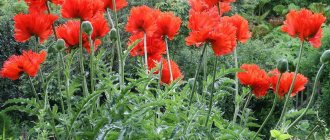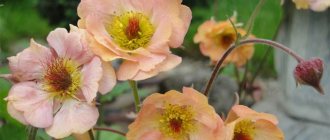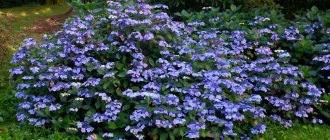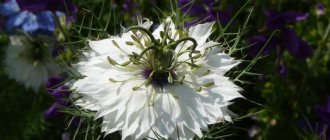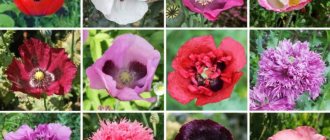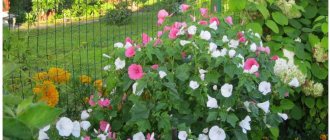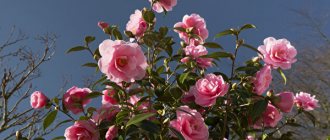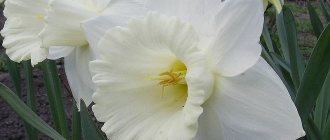Sunny coreopsis flower
The name of the flower is formed from two words in Greek: “koris” means bug and “opsis” means species. It was given to the plant because its achenes are very reminiscent of a bug in appearance.
There are about 100 different species of coreopsis in the world, most of which live in North America, but some grow in tropical regions of Africa and South America. These are flowers that love warmth and sun. Among them there are both annual species and perennial plants. Most of them are herbs, but there are also subshrubs.
Coreopsis in nature
Here we will take a closer look at some types of perennial coreopsis .
Ads by
Coreopsis perennial planting and care
Luxurious perennials will be the gardener's best choice for decorating his garden. These plants are characterized by unpretentiousness, ease of care and durability. With its bright baskets, the perennial coreopsis stands out among its motley brethren; it is a pleasure to plant and care for. Raising an exotic guest on your site will not be difficult, because it reproduces well in various ways. You will learn how to place a bright flax in the garden and provide it with proper care from the materials in the article.
Advantages of the plant
- Coreopsis grows quickly , is unpretentious in care, and can grow on a variety of soils , including dry and light sandy soils.
- It should also be noted that coreopsis is drought-resistant and prefers sunny, open places. Some species can withstand partial shading , but then the flowers are smaller and their number is smaller.
- Gardeners are also attracted by the variety of coreopsis sizes - from dwarf 15-centimeter varieties to tall varieties about a meter in height.
- And, of course, the multicolored brightness of the flowers .
Kaarina Dillabough / Flickr.com
Coreopsis: origin, description, photo
The genus Coreopsis is included in the largest family of flowering herbaceous plants - Asteraceae. It has more than 120 species of herbaceous annuals and perennials, the bulk of which come from Central America and the South American tropics. A total of 8 species are considered indigenous to North America, some are found in the tropics of Africa, in Hawaii.
Know! Gardeners loved this luxurious exotic plant with bright flowers so much that they came up with several affectionate nicknames for it: lenok, brown-eyed, Parisian beauty, sunshine in the garden, yellow daisy.
Herbaceous perennials grow from 30 to 120 cm in height, some specimens are classified as subshrubs. To comfortably endure the winter, exotics accumulate a supply of nutrients in a powerful rhizome. Their erect stems are branched and crowned with dense opposite foliage. The plates are varied in shape - pinnately dissected, lanceolate, needle-shaped, linear, palmately divided, broadly oval. A common feature is also the inflorescences in the form of baskets with jagged edges, located on long peduncles. Like other members of the Asteraceae family, the basket consists of two types of flowers - reed and tubular.
The tubular flowers are small, numerous, yellow or brown. They form a beautiful dense core of the bud. Multi-colored petals, painted in warm colors, are nothing more than reed flowers. They are located along the edges of the bud. Color varies greatly depending on the variety.
The main colors inherent in exotics are yellow, orange, pink, and red. Bicolor petals are often colored in two shades - brown at the base and the main color. That's why exotic is called brown-eyed. The number of petals affects the terryness of the basket and depends on the varietal characteristics. Many species are characterized by repeated flowering, which occurs after a short period of time from the main one.
After wilting, small achenes, similar to insects of the bug species, appear in place of the tubular flowers. They are characterized by good germination, lasting for 3-4 years.
This is interesting! Coreopsis gets its botanical name from the shape of its seeds. Literally from Latin, the name of the flower is translated “bug-like” or “bug-like.”
Flower bed design
Coreopsis is used and loved for its long-lasting blooms. It is placed in flowerbeds of perennials of continuous flowering, varying in color shades. For example, red flowers can be placed with yellow sunflowers towering in the background, blue delphiniums or next to a riot of colors of lupines.
The yellow eyes of coreopsis go well with daylilies and tall lilies. Some gardeners plant coreopsis in a bed of coniferous shrubs, using stones and ground cover plants.
Coreopsis fits into any group planting in the garden. Various combinations are used here, it all depends on your imagination.
Types, varieties of coreopsis
Yellow chamomile is beautiful in its diversity. There are annual and perennial species of this plant, but perennials are more popular among gardeners. Let us consider the characteristics of the main perennial representatives of the genus and the most popular varieties. In culture, you can most often find 5 varieties of exotics:
- coreopsis grandiflora – large-flowered;
- coreopsis verticillata – whorled;
- coreopsis rosea – pink;
- coreopsis lanceolata – lanceolate;
- coreopsis auriculata – ear-shaped.
In its native North America, the tall, stately shrub of the large-flowered variety grows in open spaces in harsh desert conditions. The desert climate is treacherous: during the day the sun mercilessly bakes, and at night the air temperature drops to almost zero degrees.
Even poor soil and an almost year-round lack of normal precipitation do not bother the exotic. For the ability to winter in the central zone without shelter, a high degree of drought resistance and decorative qualities, the unpretentious American is very fond of gardeners.
Important! This species cannot be called durable; if it is not divided once every 2-3 years, then it will not grow in one place and will gradually disappear. The plant easily tolerates frequent transplants.
The short-lived herbaceous perennial has straight, branched stems reaching a height of 0.8–1.0 m in the wild. Cultivated species are somewhat lower and more compact - the height and width of the bush is 45-60 cm. The leaf cover is divided into 2 types - in the upper part of the stem there are pinnately dissected plates, the lower leaves are whole. The decorative period begins in June and lasts until the end of summer. Large single baskets with a diameter of 5-8 cm, opening, attract pollinators. The tubular center is dark yellow, and the petals are a rich golden hue. They are great when cut and last up to 10 days.
The most popular cultivars: Baden Gold with large inflorescences and a bush 70-90 cm high; Mayfield Jant is slightly shorter; Sunburst; "Sunny Bunny"; “Early Dawn” is a compact hybrid 45 cm high, throwing out a peduncle with a single semi-double bud. The central part is painted in dark yellow tones, the edges are slightly lighter.
Remember! Most coreopsis grandiflora cultivars reproduce only vegetatively. Only the Early Dawn variety can be grown by seeds.
The whorled variety received its unusual name for the structure of thin, needle-like leaves of a light green hue, collected in whorls. The tall species reaches a height of over 1 meter and tends to occupy a large area due to the growth of rhizomes.
In the wild, it lives in light forests along the Mississippi River. Tolerant to drought, poor soils, heat. Loves plenty of sun, but feels quite normal in light partial shade. The strong, rigid stems are highly branched; on the tops there are many yellow baskets with a slightly darker middle. Depending on the variety, the diameter of the buds is 3-5 cm. The corollas open by mid-summer and delight the eye almost until the end of the season. Can grow in one place without division for up to 6 years.
The best hybrids are Moonbeam and Zagreb. Both of them are short (up to 30 cm) and have low growth rates. The Moonbeam variety has pale yellow corollas, while Zagreb has golden corollas. There is a large-flowered form of Grandiflora, which is distinguished by the abundance of baskets on the bushes.
The pink flaxen is similar in appearance to its whorled counterpart. It differs from it in its short stature of 15-30 cm and also likes to occupy a large area, growing in width up to 70-80 cm. Its flowers are small, only 2 cm in diameter with a yellow core and pink petals.
The flowering period falls in mid-summer and lasts until the end of September. Prefers moist soils with moderate levels of organic matter, because in the wild it grows along the coastline, in the swamps of North America. He doesn’t have many varieties, the best are “Sweet Dreams” up to 40 cm high with a white border along the edge of bright pink petals; "Heaven's Gate" with bushes up to 30 cm tall and abundant flowering. Pink petals acquire a purple tint towards the middle; "American Dream" 30-40 cm high with deep pink corollas.
On a note! The pink variety has a low degree of frost resistance, but gardeners highly appreciate its resistance to both drought and short-term waterlogging. It is recommended to cover it with fallen leaves for the winter.
The lanceolate lenok is native to the central region of North America, Mexico. There, medium-sized bushes 50–60 cm high are found along the sides of highways. Pointed lanceolate plates are attached to small petioles. In the upper part of the stem, their number rapidly decreases. From July to mid-September it pleases with its small drooping baskets (3-6 cm) of a golden hue. Varieties:
- Goldfink. A low cultivar 30 cm tall. The corollas are rich yellow;
- Sternthaler. Height up to 60 cm, diameter of bright yellow baskets with a burgundy eye about 6 cm;
- Golden Queen. Height 50-60 cm, golden baskets 6 cm in diameter;
- Little Sandial. A low-growing variety with a height of 30 cm. In the center of the yellow buds there is a red-brown eye;
- Rotkelchen. It has bright yellow flowers with a red center. Diameter 4-5 cm;
- Creme Brulle. The height of the cultivar reaches half a meter, the baskets are light yellow.
The auricular coreopsis is native to the southeastern United States. This perennial has a short height of 10-30 cm. Elongated oval leaves 1-6 cm long are located only in the lower part of the stems. There are serrations along the edges of the bright yellow corollas; the corolla is 4-6 cm long. After pruning, repeated flowering is possible. It reproduces vegetatively and by seeds and attracts pollinators to the garden.
Of the best hybrids noted: Nana and Zamfir. Nana has dwarf dense bushes that are prone to spreading. The buds are bright orange-yellow, the disc is yellow. Flowering is abundant from late spring to early autumn. Zamfir forms low growth with rounded leaves and orange heads. Ideal for borders and container planting.
This is interesting! In the Zamfir variety, young flowers have a grooved surface of the petals. As you age, it smoothes out.
general information
Coreopsis is another herbaceous representative of the Asteraceae family, which is easy to guess by the characteristic shape of the inflorescences-baskets. It came to us from different regions of South and North America, but has long adapted and is now growing all over the world.
Coreopsis has thin branched shoots up to 90 cm high, which resemble openwork. There are more compact and taller varieties. Narrow leaves are mainly collected from below, but single yellow buds with a diameter of up to 6 cm bloom from above. Flowering begins in the first half of summer and continues until frost.
Photo: pocvetam.ru
Coreopsis perennial planting
Planting a Parisian beauty on your site is very simple. This can be done in several ways - seedlings, sowing seeds in a flower bed and sowing before winter. You will learn about the cultivation of seedlings in the corresponding section of the article, but for now let’s talk about what conditions the exotic will require for development and lush flowering.
When to plant yellow daisies
The timing of perennial planting depends on several factors. Firstly, zoning is taken into account, and secondly, the available planting material.
If you are going to plant yellow daisies with seeds, then this can be done in spring or autumn. When planting in autumn, choose the time so that the seedlings do not have time to appear, i.e. there should already be stable frosty weather outside. Even a slight thaw will provoke the growth of the embryo and the tender seedlings will die.
The timing of spring planting varies in different regions. Thus, in Siberia, the Urals and the central zone, the plant is grown through seedlings, which makes it possible to obtain flowering specimens by the beginning of summer. Seeds are sown in open ground so that they are not damaged by frost. For insurance, you can cover the seedlings with lutrasil or agrofibre. In the south of Russia you can sow in mid-April, in the Moscow region in early May or later, but then the flax will bloom only in the next season.
Important! Remember that planting in open ground is carried out only after the return frosts have subsided. To protect the seedlings of the heat-loving American from sudden weather changes, organize a temporary shelter.
Selecting a location
To plant exotic plants on their site, gardeners often resort to a little trick. The plant is provided with conditions that are as close as possible to the natural habitat of the species in the wild.
Having studied the description of the varieties of the American guest, we can conclude that he will need an open, sunny place where a lot of snow falls in winter. The whorled and pink variety of yellow chamomile can tolerate light shading, while other species in the shade will begin to wither and lose their decorative effect. The delicate stems do not like drafts or cold winds, so the best location for the bushes would be a place close to a fence or building. Select the site in such a way that the perennial will grow on it for at least 3-4 years.
The soil
In the wild, lenok lives on poor soils, but this does not mean that in the difficult climate of another country it will feel good on the same type of substrate. An important condition that exotic plants will require from the gardener is loose, well-drained soil with a moderate degree of moisture and fertility.
Important! Pink coreopsis is suitable for soil of average fertility. On soil rich in organic matter, it will lose its decorative properties, begin to produce many shoots, but will not bloom.
To create suitable exotic conditions, add sand to too dense soil, organic matter or mineral fertilizers to poor substrates. The soil can be compacted using chernozem or humus, and at the same time its fertility will increase.
Landing technology
Before planting the Parisian beauty, prepare the area. It is better to dig it up in advance, adding the necessary components to improve the structure and fertility of the land. Prepare small planting holes at a distance of 30-40 cm from each other for low-growing cultivars and 50-60 cm for tall ones. In each hole, organize drainage from crushed stone or broken brick, since the American guest does not tolerate excess moisture in the root system area. After planting, be sure to water the area and mulch it with compost. Provide support for seedlings of tall hybrids.
If you decide to decorate your balcony with low-growing species, choose fertile soil of medium density. Be sure to place a drainage layer on the bottom of the container. The distance between specimens is 20-30 cm.
Reviews from gardeners
Lilia, 25 years old, amateur gardener, Yeysk. This flower has amazing drought resistance; even in the hottest heat it looks fresh and bright. If you sprinkle the soil with weeds and grass, you can halve the number of waterings. Over the course of a year, the perennial grows and blooms until autumn. I don’t cover it with anything for the winter - its frost resistance is quite enough for our winters.
Veniamin, 35 years old, summer resident, Nizhny Novgorod region. I planted coreopsis “Sunbeam” for the first time. The flower has grown approximately 40 cm in height. It’s very convenient for a summer residence - it’s not always possible to arrive on time, so I prefer to plant plants that tolerate water shortages well; coreopsis is one of these. The flower is very positive, sunny, looks great in flower beds and front gardens.
If you don't have enough time to care for flowers, plant coreopsis. Without requiring attention, this plant will delight you with bright, sunny flowers throughout the summer.
Caring for perennial coreopsis
The American guest will require a minimum of attention from the gardener, because it is drought-resistant and can grow without fertilizing. But to improve its decorative properties, it is recommended to take the following measures:
- observe the irrigation regime;
- carry out timely pruning and removal of faded inflorescences;
- apply organic and mineral fertilizers according to schedule;
- mulch, loosen the soil, remove weeds;
- organize support for tall cultivars;
- if necessary, take care of winter shelter.
Remember! Mulch saves the gardener from frequent watering, prevents the formation of crust on the ground, and inhibits the growth of weeds.
Watering, pruning
High drought resistance is granted to the Parisian beauty by nature. Therefore, irrigation should be rare, only when necessary. So, if the summer turns out to be rainy, then watering the exotic plant will not be required. If the hot, dry weather lasts for a long time, water the flower moderately after the top layer of soil has completely dried. When growing yellow daisies as a potted crop, water them only after the soil has completely dried.
After the first wave of flowering is complete, remove a quarter of the stems. This measure stimulates the growth of additional flower stalks and soon you can expect the appearance of new baskets. To make the bushes look neat, remove faded inflorescences in a timely manner; new ones will not keep you waiting.
Top dressing
In order for the American guest to show himself in all his glory, additional feeding will be required. Fertilizers are applied twice per season. During the budding period or a little earlier, treat the seedlings with organic fertilizer. Diluted compost is best suited for these purposes. After the first wave of abundant flowering, apply the full mineral complex in accordance with the instructions for use. If the soil on the site is too poor in minerals, fertilizing with a low concentration of potassium-phosphorus complex is allowed in the fall.
Remember! Autumn fertilizing should not contain nitrogen, which provokes shoot growth.
Loosening and supporting the plant
To improve root respiration, the space around the bush must be loosened. This is done after watering or the day after precipitation. After loosening, the ground around the bush is mulched with humus.
Large specimens of the genus Coreopsis require support, especially if they are planted alone. With crowded planting, the bushes are able to support each other, but the crowding has a bad effect on the microclimate and can lead to the development of putrefactive processes. Before active growth begins, install support. You can make it yourself using a metal-plastic pipe and elastic wire. Bend the pipe section to form a circle or rectangle and secure the ends.
Drill 4 holes around the perimeter and insert metal rods inside. Carefully install the support around the bush by inserting lengths of wire into the ground to the desired level. Such a support will be more durable than a wooden one.
Preparing the plant for winter
In central Russia, yellow daisies winter well without any shelter. If the area around the plantings is strongly blown by the wind, hill up the root collar and sprinkle with a layer of leaves. Before this, you need to remove the entire above-ground part of the bush, leaving 10 cm of stems.
In Siberia and the Urals, it is recommended to approach the organization of winter shelter more responsibly, because a heat-loving guest may not survive too low temperatures. After autumn pruning, mulch the root collar high with humus, throw a layer of spruce branches on top and cover with spunbond. Under a blanket, the plant will comfortably endure the winter cold.
Advice! The less snow falls in winter, the higher the likelihood of rhizomes freezing at extremely low temperatures. Try to create a snowdrift at least half a meter high above the shelter.
Basic care
Caring for coreopsis is quite simple and includes the usual set of loosening, removing weeds and watering.
Watering
- Watering , even in dry and hot weather, should be fairly moderate , without excess moisture. Overmoistening is a sure way to the appearance of fungal diseases.
- In general, the plant has enough precipitation .
- In rainy weather, more attention should be paid to loosening .
Linda De Volder / Flickr.com
Top dressing
- As for feeding , in the first year of the plant’s life, if organic matter was added during planting, they are not needed .
- In subsequent years, the spring they apply (according to the instructions) a full complex of mineral fertilizers with a high nitrogen content; closer to autumn it is better to fertilize with phosphorus-potassium additives.
- Mulching with humus or compost will also improve nutrition .
MalayalaM/Flickr.com
Cosmetic procedures
- If there is no need for seed material, faded are removed .
- Tall plants are supported , and fallen bushes are tied up.
- In winter , shoots of perennial species are completely cut off , annual shoots are dug up and removed from the flower garden.
Shelter for the winter
Coreopsis usually tolerates winter . If the forecast is for little snowy weather with severe frosts, it is still better to insulate the plant with dry leaf litter, spruce branches or simple hilling .
Keith Ewing / Flickr.com
Reproduction of coreopsis
Parisian beauty reproduces by seeds and vegetatively. It should be noted that you should not collect seeds from your wards if the package was marked F1. This type of seed is called a first generation hybrid. Its seeds are either sterile or do not inherit varietal characteristics. For propagation of hybrids (especially large-flowered varieties), vegetative methods are preferred - cuttings and dividing the bush.
Dividing the bush
Yellow daisy bushes need to be divided regularly. This is especially true for the large-flowered species. Which requires a transplant every 2-3 years. The remaining varieties are subjected to vegetative propagation as they grow. The best age for division is 4 years.
A few instructions for dividing will help you correctly propagate perennials on your site:
- The best time for the event is spring, when the soil and air have already warmed up (May). Autumn replanting can be carried out in the south of Russia in early September, so that the plant has time to take root before the onset of cold weather.
- Water the bush generously and carefully remove the rhizome from the ground, trying to cause minimal damage to the lateral roots.
- Clean the rhizome from the soil and cut it into several pieces with a sharp knife. Each division should have 2-3 dormant buds for resumption of growth and a developed root lobe.
- The cuttings need to be planted in a hole with slurry. To do this, the area is first fertilized, dug up, and water is poured into the holes to form a slurry.
- Plant cuttings, compact the soil, and mulch with humus.
- The transplanted specimen is already an adult plant, so it will bloom in the same season.
Know! If you need to replant a perennial, you can safely carry out your plans. The plant takes root very easily in a new place, just replant it together with a lump of earth.
By cuttings
When propagated by cuttings, the first flowering will occur only in the next season. In mid-summer, take cuttings from the most developed shoots. Make a cut 10 cm below the internode and remove the lower leaves. You can root the cuttings in a loose, fertile substrate. A mixture of humus, sand and garden soil in equal proportions is perfect for these purposes. Fill the container with substrate and plant the cuttings in it, first soak them in a heteroauxin solution for 5-6 hours.
Place boxes with layering in partial shade; you can place them under bushes. Until complete rooting, irrigate the seedlings frequently, then switch the watering to moderate mode. For the winter, cover the box with a layer of fallen leaves, cover it with spruce branches and cover it with lutrasil. Next spring you can plant the young shoots in a permanent place and wait for the first buds to appear.
Close acquaintance with the plant is the key to successful cultivation
Before you introduce coreopsis to your summer cottage, it would be wise to find out what these cute flowers are. The plant's name comes from the Greek words for "bug" and "species", referring to the mite-like shape of the achene. The flower is often used as food for special types of caterpillars. Some birds feed on its seeds. But this does not prevent the flower from delighting people with its bright lights. The coreopsis depicted in the photo is a true confirmation of this fact.
During the season, the plant can grow up to 1.2 meters in height. Some species reach only 40 cm. Outwardly, they look like dense bushes strewn with many buds. Coreopsis fruits are most often flat in shape. They resemble some types of bedbugs or ticks. The plant is grown in garden plots or city flower beds as the main decoration. About 28 species of this flower are found on the American continent. Despite this, coreopsis are in demand in Europe.
When you look at the buds of the plant from the side, they resemble field daisies. This is only at first glance. An original flower head, decorated on all sides with petals. Each of them is framed with a serrated tip, which gives it a noble appearance.
Leaf plates and petal color depend on the plant variety:
- Coreopsis grandiflora is characterized by bright yellow petals of buds on high shoots;
- pink coreopsis has small leaves, a yellow center, which is topped with soft pink petals;
- Coreopsis verticilata is loved for its jagged leaf blades and thin buds that abundantly cover the plant.
The coreopsis shown in the photo, the planting and care of which does not require special skills, is truly striking in its beauty. There are several basic rules:
- sunny place;
- soil of average fertility;
- moderate but regular watering.
Coreopsis grows best in loose soil, so you should be wise when choosing a place to plant the plant.
There are two ways to grow perennial coreopsis in your summer cottage:
- by sowing seeds;
- growing seedlings.
The main thing is to provide the plant with regular watering, enough light and air. As a result, most of the summer the summer cottage will be decorated with bright sunny lights.
Coreopsis from seeds
Most exotic species reproduce well by seeds. For regions with harsh climates, the seedling method of planting the luxurious American plant is suitable. You will learn the nuances of growing seedlings from this section of the article.
Selection and preparation of seeds for sowing
When choosing seeds, you need to take into account zoning, the possibility of placement on the site, and the desired result. If you want to fill a ridge or decorate a border, choose low-growing cultivars. Tall varieties are suitable for creating a solo composition or the central part of a mixborder.
Carefully study the information on the seed package. Remember that when purchasing hybrid seed, adult bushes are propagated only by vegetative methods. The planting diagram drawn on the packaging will help you in the future to correctly plant the perennial in the flowerbed. Pay attention to the manufacturer, try to choose seeds from large agricultural companies. Such suppliers take care of the health of the seed and carry out preventive disinfection. Large producers do not allow re-grading, so you are guaranteed to purchase the necessary cultivar.
Important! Pay attention to the expiration date of the seeds. For successful cultivation, it is better to have at least 1-1.5 years before the expiration date.
If you bought seeds, processing is not necessary. For those collected from your own garden, such a measure is necessary. You can protect seedlings from diseases by treating them for half an hour in a solution of potassium permanganate or any fungicide. After processing, rinse the material thoroughly and soak for 6-8 hours in a growth stimulator. Phytohormones activate the embryo, awaken the seed, and facilitate the germination process.
Containers, soil
For sowing, use a regular seedling box or mini-greenhouse. Inside the greenhouse, the seedlings will be provided with the necessary microclimate. Be sure to make holes to drain excess water after watering and root respiration.
The substrate for sowing must be loose and fertile. Mix 2 parts of humus with the same amount of garden soil, add half a portion of sifted sand. This soil mixture will allow you to grow healthy seedlings. Remember that garden soil may contain pest larvae, weed seeds, and fungal spores.
Attention! In order not to lose the seedlings, be sure to heat treat the soil (steaming, calcining) or water the soil with potassium permanganate and Fitosporin.
Sowing seeds
Sowing of seeds is carried out at the end of March according to the following algorithm:
- fill the container with a 1-2 cm layer of drainage - crushed stone, sand, expanded clay;
- fill the container with the treated soil mixture, compact it, water it generously;
- sow the seeds evenly, planting them to a depth of 0.5 cm;
- organize a transparent shelter - film, glass;
- Place the box on a warm, lit windowsill.
Seedling care
At a temperature of 20-22⁰C, seedlings will appear in 2-3 weeks. They will require standard care for flower seedlings. After germination, remove the cover and slightly reduce the temperature. Provide uniform, intense lighting and keep the soil in the box moist. A slight decrease in temperature will protect the seedlings from stretching. If necessary, install additional lighting. When using a fertile substrate, fertilizing can be applied once, after picking. A complete mineral complex will help seedlings quickly adapt to new conditions and increase green mass.
Picking seedlings
I pick seedlings at the stage of 2-3 true leaves. Transplantation is carried out in separate containers using the same soil mixture that was prepared during sowing. Water the boxes with seedlings generously, remove the seedlings one at a time and place them in a larger container. Add the required amount of substrate, compact, and water.
When and how to plant seedlings in open ground
Planting seedlings in open ground can be done strictly after the last spring frosts have subsided. By this moment, most of the specimens will have gained color and grown powerful shoots.
Advice! 2-3 weeks before transplanting, harden the seedlings, leaving them in natural conditions for the whole day. This needs to be done gradually.
In Siberia, planting begins no earlier than the first ten days of June, in the middle zone by mid-May, and southerners can plant seedlings as early as the end of April. If the weather suddenly changes its character, first cover the tender seedlings with lutrasil. Transplantation is carried out into the wells in the manner described above. Follow the recommended distance between bushes indicated on the seed package. For tall hybrids 50-60 cm, for short ones 20-30 cm.
My experience in growing whorled coreopsis
I first saw this flower in photographs of Western websites and, as they say, fell in love. However, my search for the Lemon Punch and Mango Punch varieties that captured my heart was unsuccessful. However, the fact that on some sites these varieties were listed in catalogs, although they were not available at that moment in time, left me with hope of one day finding them.
And finally, I was finally able to order a few cuttings (which were sold as the Lemon Punch ) and plant them in my garden. But when the plants finally bloomed, I realized that I had been misled, and in front of me was a completely different variety of coreopsis - “Buttermilk” . Then I began to more carefully study Western sources to find out why the charming coreopsis of the “Punsh” series are so elusive in our country.
The answer was found quite quickly. Despite the fact that whorled coreopsis belongs to winter hardiness zone 3-4, some hybrid lines have much lower winter hardiness. In particular, coreopsis of the “Punsh” line is grown as a heat-loving annual even in Europe, not to mention Russia. And its presence in catalogs with perennials is someone’s mistake.
As for the “Buttermilk” variety, which I purchased, this cultivar is considered to be quite winter-hardy, and can easily overwinter in zone 5 regions even without shelter. The appearance of the coreopsis “Buttermilk” seemed to me no less cute than that of the “Punsh” series. In addition, in my conditions it grew in low fluffy bushes no more than 25 centimeters in height and never reached the 40 centimeters stated in the description of the variety.
This coreopsis overwinters without any problems, however, it has one peculiarity. Perhaps this is due to my type of soil (heavy, wet with a high groundwater level), but the next year after planting the bushes turned out to be less branched than in the first season, but they bloomed larger flowers. And although most perennials usually grow over time, this coreopsis has been practically sitting still for several years. I had to plant the bushes as close as possible so as not to lose the decorative effect.
Otherwise, coreopsis is quite unpretentious and grows in a natural flower garden with virtually no care. Closer to autumn, I observed a slight infection of powdery mildew on its foliage, but I did not take protective measures, and the plant, in principle, steadfastly endured this disease. As for the neighbors, I most liked combining this variety with oak sage, burnet, bush sedum and low grasses (for example, bulbous ryegrass).
Another variety of whorled coreopsis “Zagreb” also came to me as a re-cultivation. It differs from coreopsis “Buttermilk” not only in the brighter, rich yellow color of its petals, but also in completely different growth characteristics. It has wider, feathery, dark green leaves that are not affected by powdery mildew.
This coreopsis grows quite quickly and requires regular division, and it is also not tall in height - up to 20 centimeters. And finally, this is the most winter-hardy representative of the species, which can successfully winter in zone 3. And I even overwintered in flowerpots, where it grew in compositions with annual plants.
Coreopsis "Zagreb" can be called a perennial for lazy gardeners. But I didn’t really like it because of its too rich yellow color, since I prefer bed shades in the garden.
Planting perennial coreopsis in open ground with seeds
Seeds can be sown in open ground in such a way that by the time the seedlings emerge, the frosts have already passed. Mid-May for Siberia and the Urals, mid-April for the South of Russia and early May for the Middle Zone. Sow prepared seeds into moistened holes without deepening them. Sprinkle with a thin layer of soil. To speed up germination, throw a film over the hole. In 2 weeks, friendly shoots will appear. They are thinned out at the stage of development of the third leaf, leaving only strong specimens. Further care is the same as for adult plants.
In the South, you can sow seeds before winter, in early November. Planting conditions are similar to those described above. With the arrival of spring, sprouts will hatch, which are then thinned out and cared for as usual.
When and how does it bloom
Different varieties may have very different flowering times, ranging from 2 to 6 months, usually ending with the arrival of frost.
Types of flowers
Coreopsis has simple and double flowers. Separately, it is worth noting the ear-shaped varieties with marginal ligulate flowers rolled into tubes with jagged edges along the edge of the inflorescence-baskets.
Simple inflorescence basket
Flower shapes
The most common flower shape is a simple basket, with an even number of long ligulate flowers around the edge and many short tubular flowers in the center. In double varieties, all the flowers in the inflorescence-basket are approximately the same - long.
Double inflorescence
Flowering period
The minimum duration is 80 days. Coreopsis usually bloom from May to September, some varieties from July to October, but there are also earlier varieties.
Changes in care during the flowering period
When the first buds bloom, complex mineral fertilizer should be applied. Further feeding is carried out every month. Watering is carried out as needed.
Note! It is best to cut off wilted buds if there is no goal of obtaining seeds.
Pests and diseases of coreopsis
The strong immunity of the exotic in alien climatic conditions made it vulnerable to fungal diseases - fusarium and rust. With fusarium blight, the fungus attacks the leaves, causing them to quickly yellow and die. Rust is characterized by the appearance of reddish-brown spots containing fungal spores. Gradually, the spots grow, interfere with normal photosynthesis, and the leaves die. If there are signs of disease, remove the affected parts and treat the bush with Fitosporin.
Attention! Much worse for the Parisian beauty is infection by plant viruses. In case of stunted growth, deformation of the baskets, or “curly” bushes, immediately remove the diseased individuals and burn them.
Of the pests, the American is only interesting to aphids, beetles and caterpillars. Aphids can be washed off with a soap solution or marigold decoction. If the treatment does not bring results, use insecticides - Karate, Intavir, Iskra. It is recommended to collect beetles and caterpillars by hand and destroy them.
Coreopsis perennial in landscape design
The bright buds of this exotic perennial will give a good mood to everyone who decides to plant it in the flowerbed. Landscape designers use tall hybrids to create the background of a mixborder, large flower bed, or alpine slide. They are relevant both in single and group plantings, for decoration in front of the entrance to the site.
The best neighbors for tall cultivars will be irises, sage, delphiniums, and chamomile-like relatives from the Asteraceae family - zinnia, echinacea, and rudbeckia. When cut, yellow-orange elegant bouquets will last 7-10 days.
Low-growing varieties are ideal for filling ridges, planting in rock gardens, finishing paths and borders. They are grown in small boxes to decorate balconies.
A cheerful guest from America, coreopsis, will grow in a flowerbed even for novice gardeners, because planting and caring for it are simple.
Use in the garden
The versatile use of coreopsis as an ornamental plant is noteworthy; it can be grown in small garden plots, naturalistic gardens, and rock gardens.
Large-flowered coreopsis is suitable for flower beds in combination with plants with brightly colored flowers. Also looks good when planted in flower beds with blue flowers. Tall varieties are grown in flower beds and for bouquets; dwarf varieties are suitable for growing in containers and rock gardens.
Whorled coreopsis creates a beautiful border around a flower bed; it can be planted along garden paths or decorate the entrance to a house. Fast-growing varieties are well suited for growing in containers - on sunny balconies, patios, terraces.
Plants are most beautiful when planted in large groups in the company of other perennials that require full sun, such as:
- goldenrod;
- medium bell;
- oak sage;
- Gaillardia spinosa.
Ipomoea purpurea makes an excellent background for yellow flowers.
